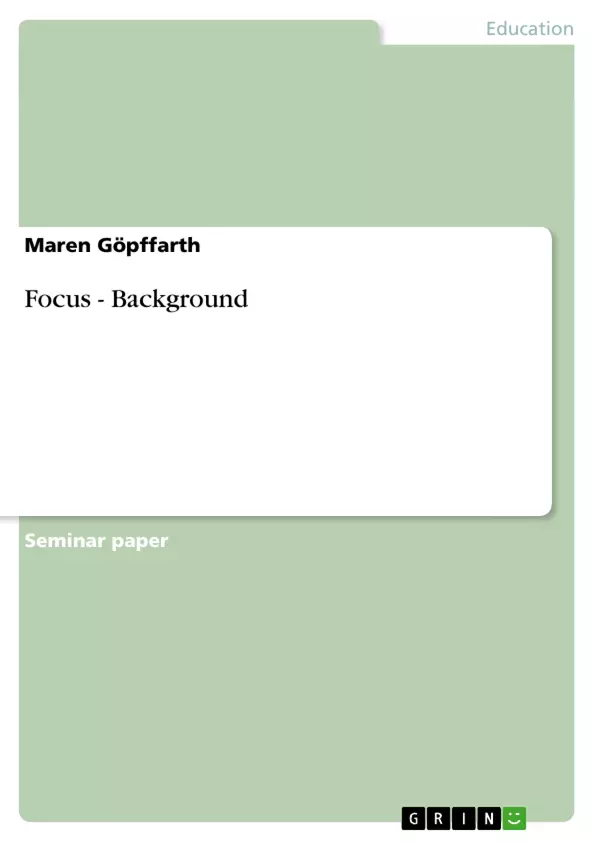Language is and has always been the most important means of communication. We exchange information by talking or writing to each other; we read books, magazines, newspapers or any kind of written text either for personal entertainment or reading for intensive studies to find out what is going on. For my responsible future work as a teacher in primary schools it is very important and interesting for me to analyse and understand the structure of language. Therefore, I need as well a background knowledge about Information Structure in order to be able to give for example adequate answers to the pupils’ questions concerning sentence structures. The course”Information Structure: The Interface of Syntax, Pragmatics, and Phonology” helped me to appreciate this topic better. “Information Structure means the division or organisation of the sentence/utterance and its elements according to the discourse situation.” (Dr. Nicole Dehé 2003) A typical situation is for example an interview or a conversation. There must be more than one speaker because “Information Structure reflects the relationship between the speaker’s assumption about the hearer’s state of knowledge and consciousness at the time of an utterance and the formal structure of the sentence.” (Dr. Nicole Dehé 2003) According to this defintion there must be at least one hearer and one speaker. Information Structure sentences can be analysed in terms of “information packaging”1 such as theme, rheme, topic, comment, focus, background, dominance, ground (link, tail), given and new. This term paper highlights the catagory focus – background. In the first part I will give a short overview of the catagories and explain them in the following way: Firstly I will give a short definition of the category, then I will give one or two examples and at the end I will discuss possible problems. Then I will have a closer look at the focus – background topic. After that I will analyse the interview with Bryan Adams basing on the catagory focus – background. Finally a brief summary about this term paper will be given. 1 „I have been using the term packaging to refer to the kind of phenomena at issue here, with the idea that they have to do primarily with how the message is sent and only secondarily with the message itself, just as the packaging of toothpaste can affect sales in partial independence of the quality of the toothpaste inside.” (Wallace Chafe:28)
Inhaltsverzeichnis (Table of Contents)
- 1. Introduction
- 2. An overview of the dichotomies and categories of Information Structure
- 2.1 Theme-Rheme
- 2.2 Topic-Comment
- 2.3 Focus-Background
- 2.4 Given-New
- 2.5 Dominance
- 2.6 Ground(Link-Tail)-Focus
- 3. Focus-Background
- 3.1 Definition of Focus-Background
- 3.2 Definition of Broad-Focus and Narrow-Focus
- 3.3 Examples for the different types of Focus
- 4. Applying the Focus -Background: An interview with Bryan Adams
- 5. Summary
Zielsetzung und Themenschwerpunkte (Objectives and Key Themes)
This paper aims to analyze the category of focus-background within the broader framework of information structure. It seeks to provide a detailed explanation of focus-background, including its definition and various types. The paper utilizes an interview with Bryan Adams to illustrate the practical application of focus-background principles.
- Information structure and its various categories
- The definition and types of focus-background
- The role of focus-background in communication
- Analyzing information structure in real-world discourse
- Applying focus-background to understand spoken language
Zusammenfassung der Kapitel (Chapter Summaries)
- Chapter 1: Introduction: This chapter introduces the concept of information structure and its importance in language communication, particularly for future teachers. It highlights the relevance of analyzing sentence structure and understanding information structure to effectively address student inquiries.
- Chapter 2: An overview of the dichotomies and categories of Information Structure: This chapter provides an overview of different categories within information structure, including theme-rheme, topic-comment, focus-background, given-new, dominance, and ground (link-tail)-focus. It explains each category with examples and discusses potential problems associated with their application.
- Chapter 3: Focus-Background: This chapter focuses on the definition and various types of focus-background, including broad-focus and narrow-focus. It provides examples to illustrate how focus-background functions in sentences.
- Chapter 4: Applying the Focus -Background: An interview with Bryan Adams: This chapter delves into the practical application of focus-background by analyzing an interview with Bryan Adams. It explores how focus-background is used in real-world discourse to convey information and structure conversational turns.
Schlüsselwörter (Keywords)
Key concepts and focus topics include information structure, theme-rheme, topic-comment, focus-background, given-new, dominance, ground (link-tail)-focus, broad-focus, narrow-focus, discourse analysis, conversation analysis, and spoken language communication.
- Quote paper
- Maren Göpffarth (Author), 2003, Focus - Background, Munich, GRIN Verlag, https://www.grin.com/document/31325



